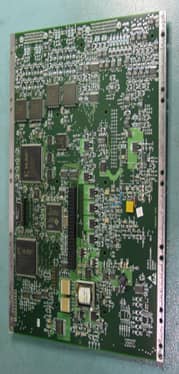In a company that handles recurring small batch work on printed circuit board assembly, project requirements and specifications can vary a lot. The key to delivering high-quality work in a timely manner is to get the project methodology down to a science. It can't be done without a solid understanding on both sides of the contract: the assembling company must know what the customer needs, and the customer must validate that work undertaken by the company is accurate.
 We have a procedure to see that both these needs are met. It goes like this:
We have a procedure to see that both these needs are met. It goes like this:
- The new quoting opportunity gets assigned to a Customer Centric Team (CCT). This team consists of a Customer Liaison, an Engineer, and a Buyer.
- We start with a detailed task breakdown, analyzing the project through every anticipated life stage. The CCT Engineer goes over the customer's documents in detail, and outlines a plan to handle anticipated snags.
- All of the assembly requirements are meticulously documented, and estimated labor requirements are calculated.
- The CCT Buyer sources each of the component parts and negotiates for the best pricing.
- Throughout the manufacturing cycle, we continually measure and report progress. Our CCT coordinates and prioritizes the work, using their familiarity with the customer's specifications as a guide. They also keep the lines of communication open to identify problems as fast as possible – after all, the sooner a problem's identified, the sooner it's solved.
- Software modules undergo early testing, and the printed circuit boards are put through integrated system testing.
It's a system that's been refined over the course of four decades, and it allows us to deliver consistently superior results.
The customer should always be kept fully informed during the process. When the customer gets a proposal, here are some points to look for:
- Accuracy, first and foremost. Double-check that the proposal matches your requirements; RBB will produce printed circuit boards in accordance with the documents provided, manufactured to your electrical and environmental requirements, and tested to our highest standards.
- The bill of materials (BOM) is open to review by the customer, and any exceptions should be noted. The BOM should cover both hardware and software aspects of the boards.
- There should be a step-by-step assembly plan, listing all of the manufacturing stages applicable to your order. This includes purchasing, component preparation, kitting, assembly, programming, and all other stages of manufacturing.
- A plan detailing the quality process, including inspection, test procedures, and serialization.
- Additional quality testing available upon requirement, such as burn-in testing and in-circuit testing, if it's applicable to your circuit board assembly order.
- The testing guidelines should be clearly stated.
- Deliverables should be listed for review, including customer-company contact and coordination.
- Any exceptions or assumptions that might change the standard proposal should be clearly stated, including conversion for RoHS compliance.
- Check your pricing summary, which includes any non-recurring engineering charges that may be assessed.
- Shipping information should be available up-front, with a maximum and estimate.
- Any special conditions, such as terms of proposal expiration, should also be listed.
With this detailed proposal, the customer will know exactly what they're getting into, and how to keep abreast of the manufacturing project as it develops. Any concerns can be brought directly to their contact and addressed without hassle, and with the highest standards of accountability.
Bruce loves to manage change and to encourage working environments where employees and customers thrive. His passion led him to found ODS – a highly practical leadership, trust and communication training firm and blog. He’s a noted speaker, author, active church member and community volunteer. Bruce has led RBB since 2001, becoming Owner in 2007.






